Digital Biomarker Market Size
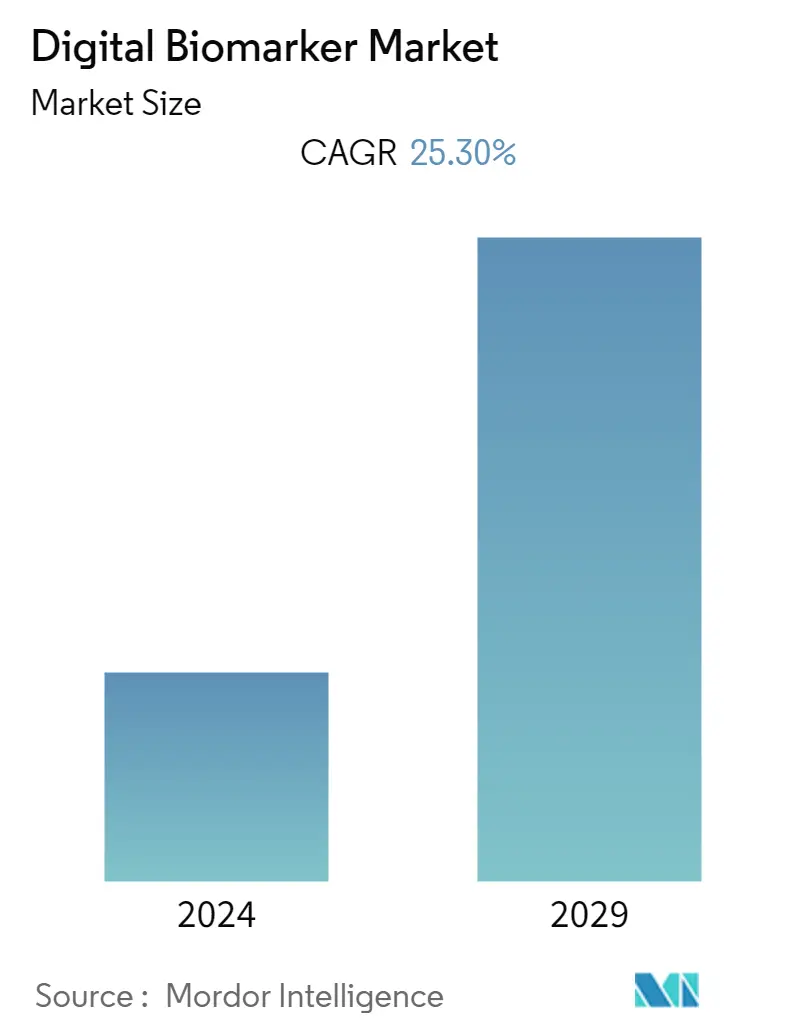
| Study Period | 2020-2028 |
| Base Year For Estimation | 2022 |
| CAGR | 25.30 % |
| Fastest Growing Market | Asia-Pacific |
| Largest Market | North America |
| Market Concentration | High |
Major Players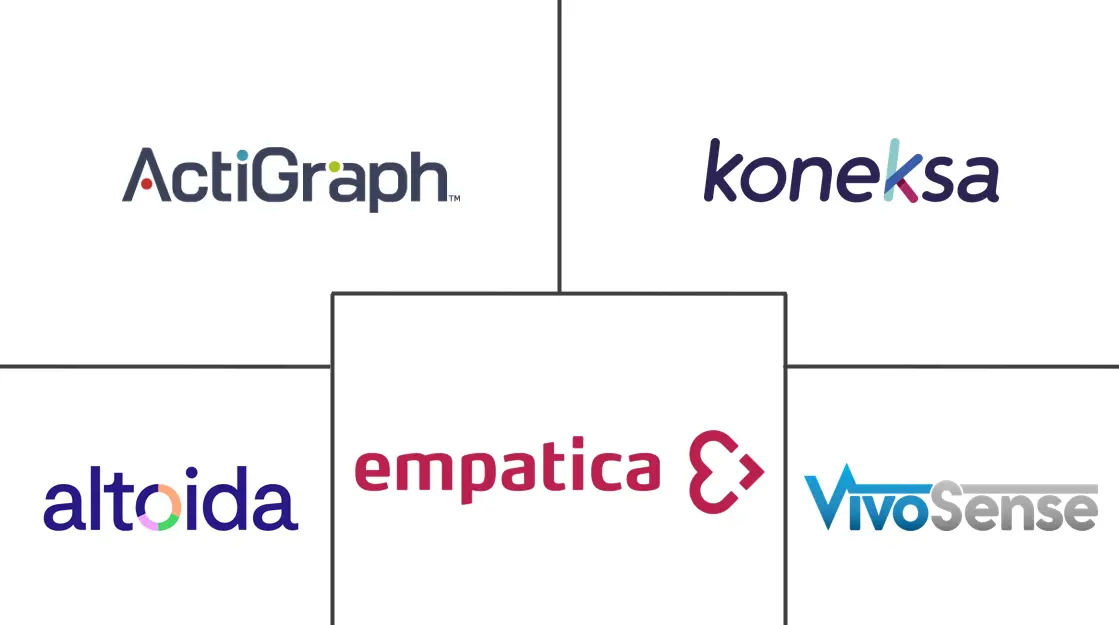
*Disclaimer: Major Players sorted in no particular order |
Need a report that reflects how COVID-19 has impacted this market and its growth?
Digital Biomarker Market Analysis
The digital biomarker market is expected to register a CAGR of 25.3% over the forecast period.
- The COVID-19 pandemic significantly impacted the digital biomarker market in 2020, with an increasing number of COVID-19 patients fueling the demand for remote patient monitoring devices such as wearables, patches, and others. This led to a higher adoption rate of digital biomarkers during the pandemic. A survey by MSI International published in 2021 reported that 80% of the United States population favored adopting a remote patient monitoring system. According to an article by Multidisciplinary Digital Publishing Institute (MDPI) in December 2022, wearables were helpful for better COVID-19 care by detecting asymptomatic and pre-symptomatic cases, ongoing patient conditions, and long-term COVID monitoring of recovered patients and healthy individuals.
- Research studies have recognized digital biomarkers as an optimum early detection mechanism for COVID-19. For instance, according to a research article by the Public Library of Science in October 2022, an accurate and calibrated voice biomarker can be derived using a machine learning algorithm to track the resolution of COVID-19-related symptoms, resulting in higher demand for digital biomarkers for the early detection of COVID-19 symptoms during the pandemic and supporting the growth of the market.
- The integration of artificial intelligence (AI) in developing digital biomarkers and the increasing usage of wearable devices and smartphones among the general population is fostering the adoption rate of digital biomarkers during the study period. The introduction of advanced software platforms, wearable devices, and sensors is further fueling the adoption rate among healthcare professionals during the study period.
- The application of AI in healthcare is increasing in a significant manner. According to an article by Neoteric sp. z o.o. in February 2022, the implementation of AI in healthcare assisted healthcare professionals in a wide range of areas, including improving the efficacy and accuracy of diagnostic procedures, speeding up drug development, and developing new tools for medical research such as genome sequencing and annotation, among others. This increasing application of AI in healthcare is also fueling the integration of AI in digital biomarkers.
- For example, Paige AI, Inc. announced a collaboration with Janssen Research & Development, LLC, to examine the potential of a hematoxylin and eosin (H&E)-based, artificial intelligence (AI)-powered biomarker test for the diagnosis of advanced urothelial cancer. As a result of this study, healthcare professionals can evaluate precise results within a short span of time.
- Moreover, the increasing preference for wearable monitors and sensors for diagnostic and monitoring purposes, as well as the rising inclination towards sharing the data from these digital biomarkers with healthcare professionals, is expected to grow the market for digital biomarkers in the near future. A survey published by Software Advice, Inc. in September 2021 reported that among 485 surveyed wearable device-using patients from the United States, 96% were interested in sharing the data collected by these devices with healthcare professionals for an improved understanding of the healthcare parameters. According to a survey by TechTarget, Inc. in September 2022, the average number of digital tools used by a single physician increased by almost 73% in 2022 compared to 2016.
- The increasing prevalence of neurodegenerative disorders such as Alzheimer's, cognitive impairment, multiple sclerosis, Parkinson's disease, and others is increasing the demand for precise monitoring and treatment options. According to Alzheimer's Research UK, a 50% increase was observed in the diagnosis rate for dementia from 2010-2011 to 2021-2022 among UK citizens of the age group of more than 65 years. This rising patient population is increasing the demand for precise digital biomarkers to monitor the risk state. A research study published by MDPI in July 2022 reported that most of the digital cognitive biomarkers proved to be better than traditional ones.
Digital Biomarker Market Trends
The Wearable Devices Segment is Anticipated to Register a Significant Growth
- The focus on wearable devices for health monitoring is expected to drive growth opportunities for this segment during the study period. According to an article published by IT World Canada in May 2022, one-third of Canadians were using at least one wearable monitoring device in 2022, and 61% of Canadians were planning to increase their use of wearable technologies in 2023. Additionally, gfu Consumer & Home Electronics GmbH reported that an estimated 7.4 million wearables were sold in Germany in 2021, which supports the high adoption of wearable monitors during the study period.
- Moreover, the introduction of advanced wearable devices by key players is also driving adoption rates of this technology during the study period. For instance, in February 2022, Abbott introduced consumer bio wearables called Lingo, designed to track body signals such as glucose, ketones, and lactate.
- Similarly, in January 2021, Abbott entered into a partnership with Apple Inc. with the aim of developing cognitive health biomarkers using the Apple Watch for mild cognitive impairment. These initiatives by major players are fostering the adoption rate of wearables as a digital biomarker during the study period.
- Therefore, the factors mentioned above are the primary drivers of significant growth in this segment of the market during the study period.
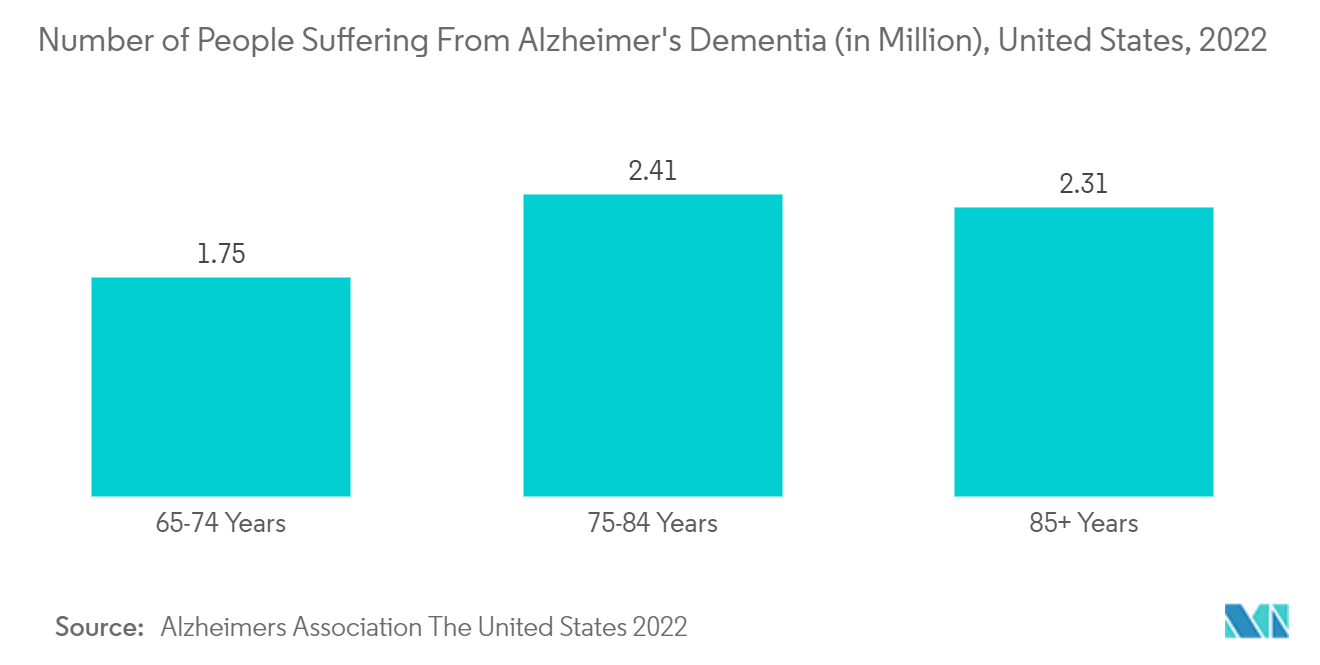
North America is Anticipated to Dominate the Digital Biomarker Market
- North America is expected to dominate the digital biomarkers market during the forecast period, primarily due to several factors. Firstly, there is an increasing focus on health awareness among the population in the region, which has led to rising demand for wearable devices, patches, and other biomarkers. Moreover, the region has seen a growing number of FDA approvals for medical-grade digital biomarkers, further driving market growth.
- For instance, in November 2022, Empatica received Food and Drug Administration (FDA) approval for the Empatica Health Monitoring Platform, which is expected to offer precise health monitoring and data collection software for research and healthcare professionals. Similarly, in August 2022, Bodyport received FDA approval for the Bodyport cardiac scale, a biomarker platform that provides accurate insights into heart health and the fluid status of the body.
- These developments by major players are expected to provide lucrative growth opportunities for the region during the forecast period. Additionally, the rising prevalence of chronic diseases, such as neuron degenerative disorders and cardiovascular disorders, and the increasing use of digital biomarkers for diagnosis and monitoring are also contributing to the market's growth.
- For instance, according to a November 2022 article by RAND Corporation, an estimated 6.2 million people in the United States aged 65 years and older were living with dementia in 2021. Furthermore, a study published by Frontiers Media S.A. in August 2022 stated that digital biomarkers are more precise in detecting dementia and predicting future outcomes than traditional biomarkers. This research study reported that the digital neurosignature biomarker of brain resilience (DNS-br) is a precise predictor of global cognitive functioning compared to traditional imaging biomarkers and biological markers of brain health and resilience.
- Therefore, with the growing demand for wearable devices, increasing number of FDA approvals for digital biomarkers, and rising prevalence of chronic diseases, North America is expected to maintain its leading position in the digital biomarkers market during the forecast period.
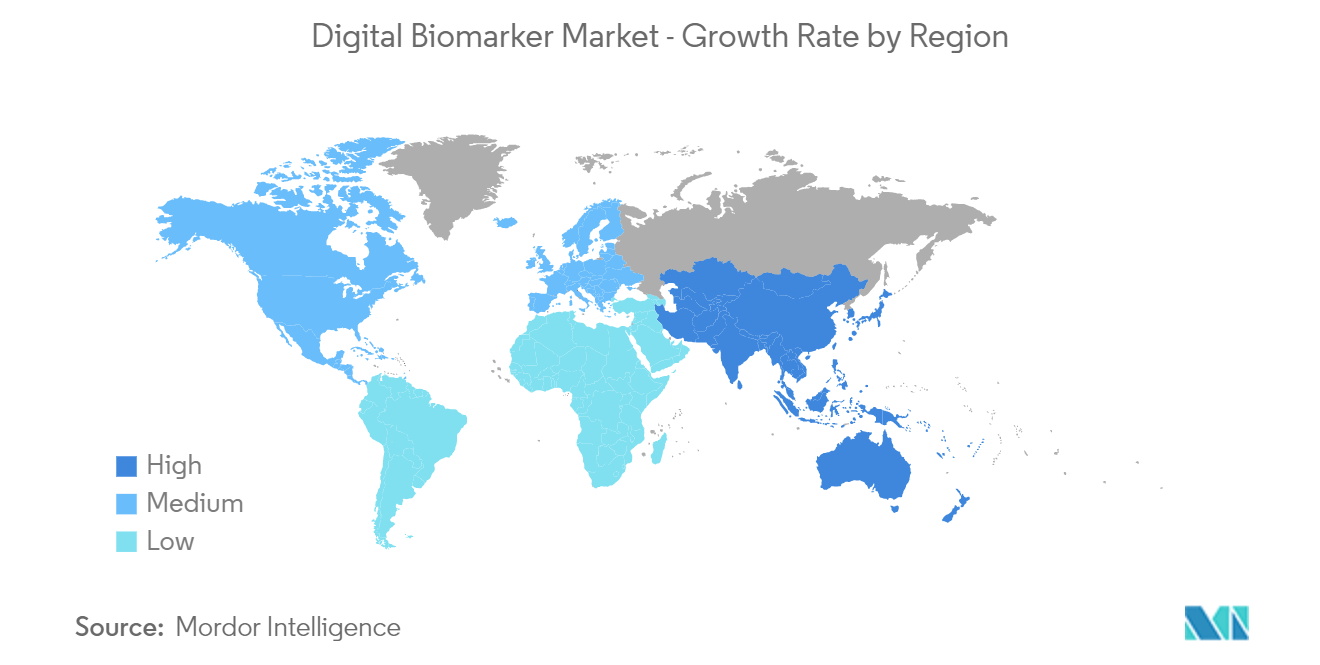
Digital Biomarker Industry Overview
The digital biomarker market is consolidated in nature due to the presence of a few players with approved products that are commercialized across the world. The competitive landscape includes an analysis of a few international as well as local companies which hold market shares and are well known. include ActiGraph, LLC, Koneksa, Altoida, Empatica Inc., VivoSense, Adherium, Aural Analytics, Huma, Sonde Health, Inc., Neurotrack Technologies, Inc., and Medtronic among others.
Digital Biomarker Market Leaders
ActiGraph, LLC
Koneksa
Altoida
Empatica Inc.
VivoSense
*Disclaimer: Major Players sorted in no particular order
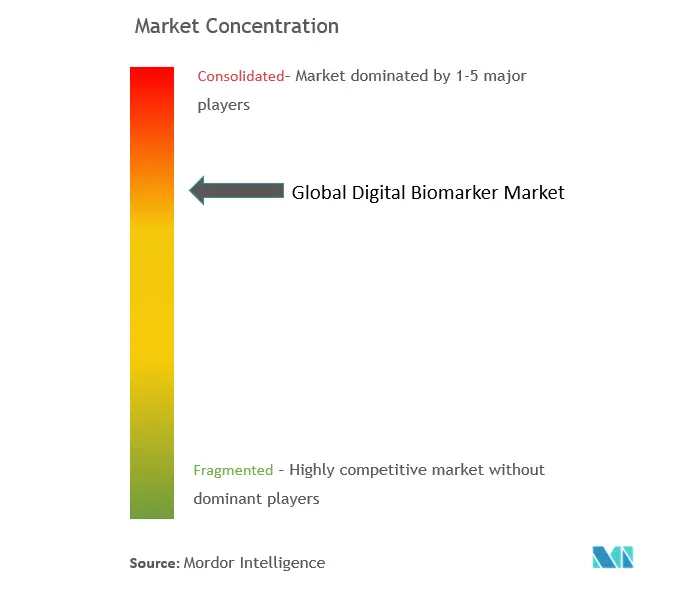
Digital Biomarker Market News
- March 2022: Mitsubishi Tanabe Pharma America (MTHA) announced a partnership with EverythingALS with the aim of developing and providing digital biomarkers for amyotrophic lateral sclerosis. The partnership aims to utilize digital technology to advance the understanding of the disease and to support clinical trial design and patient management.
- March 2022: AstraZeneca entered into a collaboration with Huma, a digital health platform, with the aim of combining predictive algorithms, digital biomarkers, and real-world data to develop and offer software solutions. The collaboration seeks to provide new insights and improve decision-making for patients and healthcare providers in disease management and clinical research.
Table of Contents
1. INTRODUCTION
1.1 Study Assumptions and Market Definition
1.2 Scope of the Study
2. RESEARCH METHODOLOGY
3. EXECUTIVE SUMMARY
4. MARKET DYNAMICS
4.1 Market Overview
4.2 Market Drivers
4.2.1 Integration of Advanced AI in the Healthcare
4.2.2 Increasing Use of Wearable Device and Smartphone
4.3 Market Restraints
4.3.1 Risk of Data Breaching
4.4 Porter's Five Forces Analysis
4.4.1 Threat of New Entrants
4.4.2 Bargaining Power of Buyers/Consumers
4.4.3 Bargaining Power of Suppliers
4.4.4 Threat of Substitute Products
4.4.5 Intensity of Competitive Rivalry
5. MARKET SEGMENTATION (Market Size by Value - USD million)
5.1 By Product Type
5.1.1 Wearble Devices
5.1.2 Softwares
5.1.3 Sensors
5.2 By Application
5.2.1 Monitoring Biomarker
5.2.2 Predictive Biomarkers
5.2.3 Diagnostics Biomarker
5.2.4 Other Applications
5.3 By End-User
5.3.1 Biopharmaceutical Companies
5.3.2 Healthcare payer and Providers
5.3.3 Other End-Users
5.4 Geography
5.4.1 North America
5.4.1.1 United States
5.4.1.2 Canada
5.4.1.3 Mexico
5.4.2 Europe
5.4.2.1 Germany
5.4.2.2 United Kingdom
5.4.2.3 France
5.4.2.4 Italy
5.4.2.5 Spain
5.4.2.6 Rest of Europe
5.4.3 Asia-Pacific
5.4.3.1 China
5.4.3.2 Japan
5.4.3.3 India
5.4.3.4 Australia
5.4.3.5 South Korea
5.4.3.6 Rest of Asia-Pacific
5.4.4 Middle-East and Africa
5.4.4.1 GCC
5.4.4.2 South Africa
5.4.4.3 Rest of Middle East and Africa
5.4.5 South America
5.4.5.1 Brazil
5.4.5.2 Argentina
5.4.5.3 Rest of South America
6. COMPETITIVE LANDSCAPE
6.1 Company Profiles
6.1.1 ActiGraph, LLC
6.1.2 Koneksa
6.1.3 Altoida
6.1.4 Empatica Inc.
6.1.5 VivoSense
6.1.6 adherium
6.1.7 Aural Analytics
6.1.8 Huma
6.1.9 Sonde Health, Inc.
6.1.10 Neurotrack Technologies, Inc.
6.1.11 Medtronic
- *List Not Exhaustive
7. MARKET OPPORTUNITIES AND FUTURE TRENDS
Digital Biomarker Industry Segmentation
As per the scope of the report, the digital biomarker assists in detecting, monitoring, assessing the risks, and predicting the possible treatment options for several disease conditions, including autoimmune diseases, neurology, and cardiology, among others.
The digital biomarker market is segmented by product type (wearable devices, software, and sensors), application (monitoring biomarkers, predictive biomarkers, diagnostics biomarkers, and others), end-user (biopharmaceutical companies, healthcare payers & providers, and others), and geography (North America, Europe, Asia-Pacific, Middle East, and Africa, and South America). The report also covers the estimated market sizes and trends for 17 countries across major regions globally.
The report offers the value (in USD million) for the above segments.
| By Product Type | |
| Wearble Devices | |
| Softwares | |
| Sensors |
| By Application | |
| Monitoring Biomarker | |
| Predictive Biomarkers | |
| Diagnostics Biomarker | |
| Other Applications |
| By End-User | |
| Biopharmaceutical Companies | |
| Healthcare payer and Providers | |
| Other End-Users |
| Geography | ||||||||
| ||||||||
| ||||||||
| ||||||||
| ||||||||
|
Frequently Asked Questions
What is the current Digital Biomarker Market size?
The Digital Biomarker Market is projected to register a CAGR of 25.3% during the forecast period (2023-2028).
Who are the key players in Digital Biomarker Market?
ActiGraph, LLC, Koneksa, Altoida, Empatica Inc. and VivoSense are the major companies operating in the Digital Biomarker Market.
Which is the fastest growing region in Digital Biomarker Market?
Asia-Pacific is estimated to grow at the highest CAGR over the forecast period (2023-2028).
Which region has the biggest share in Digital Biomarker Market?
In 2023, the North America accounts for the largest market share in the Digital Biomarker Market.
Digital Biomarker Industry Report
Statistics for the 2023 Digital Biomarker market share, size and revenue growth rate, created by Mordor Intelligence™ Industry Reports. Digital Biomarker analysis includes a market forecast outlook to for 2023 to 2028 and historical overview. Get a sample of this industry analysis as a free report PDF download.
